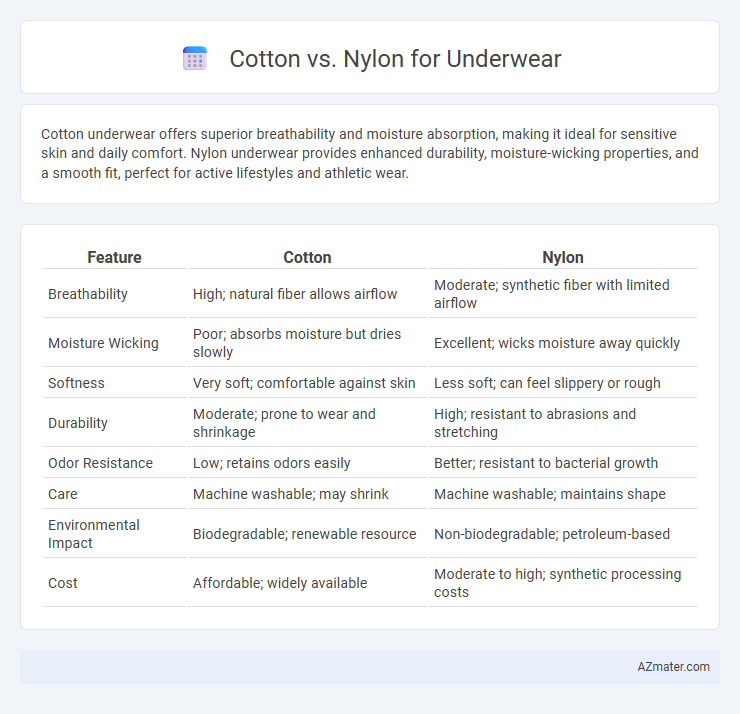Cotton underwear offers superior breathability and moisture absorption, making it ideal for sensitive skin and daily comfort. Nylon underwear provides enhanced durability, moisture-wicking properties, and a smooth fit, perfect for active lifestyles and athletic wear.
Table of Comparison
| Feature | Cotton | Nylon |
|---|---|---|
| Breathability | High; natural fiber allows airflow | Moderate; synthetic fiber with limited airflow |
| Moisture Wicking | Poor; absorbs moisture but dries slowly | Excellent; wicks moisture away quickly |
| Softness | Very soft; comfortable against skin | Less soft; can feel slippery or rough |
| Durability | Moderate; prone to wear and shrinkage | High; resistant to abrasions and stretching |
| Odor Resistance | Low; retains odors easily | Better; resistant to bacterial growth |
| Care | Machine washable; may shrink | Machine washable; maintains shape |
| Environmental Impact | Biodegradable; renewable resource | Non-biodegradable; petroleum-based |
| Cost | Affordable; widely available | Moderate to high; synthetic processing costs |
Introduction to Cotton vs Nylon Underwear
Cotton underwear offers exceptional breathability and moisture absorption, making it ideal for sensitive skin and everyday comfort. Nylon underwear provides superior durability, elasticity, and quick-drying properties, suitable for active lifestyles and athletic use. Choosing between cotton and nylon depends on personal preferences for comfort, performance, and fabric care.
Fabric Overview: Cotton and Nylon
Cotton is a natural fiber known for its breathability, softness, and moisture absorption, making it ideal for everyday underwear that prioritizes comfort and skin health. Nylon, a synthetic fiber, offers superior strength, elasticity, and quick-drying properties, which enhance durability and support in performance or athletic underwear. Both fabrics serve different purposes, with cotton excelling in natural comfort and nylon providing resilience and moisture management.
Comfort and Softness Comparison
Cotton underwear offers superior comfort and softness due to its natural fiber structure, which allows excellent breathability and moisture absorption, reducing skin irritation and promoting all-day comfort. Nylon, a synthetic fabric, tends to feel smoother and more lightweight but can trap heat and moisture, sometimes causing discomfort during extended wear. For those prioritizing softness and comfort, especially in sensitive skin, cotton remains the preferred choice over nylon.
Breathability and Moisture Management
Cotton underwear offers superior breathability due to its natural fibers, allowing air to circulate and reducing heat buildup. Nylon, a synthetic fabric, excels in moisture management by wicking sweat away from the skin and drying quickly, which helps maintain comfort during physical activity. Choosing between cotton and nylon depends on whether breathability or moisture-wicking performance is the priority for daily wear or exercise.
Durability and Longevity
Nylon underwear offers superior durability and longevity compared to cotton due to its synthetic fibers, which resist wear, stretching, and shrinking over time. Cotton, while breathable and comfortable, tends to degrade faster with frequent washing and prolonged use, often showing signs of thinning and fading. Choosing nylon for underwear ensures better resistance to abrasion and sustained shape retention, extending the garment's lifespan significantly.
Skin Sensitivity and Allergy Risks
Cotton underwear is highly recommended for individuals with sensitive skin due to its natural, breathable fibers that minimize irritation and reduce the risk of allergic reactions. Nylon, being synthetic, can trap moisture and heat, potentially causing discomfort or exacerbating skin sensitivities and allergies. Choosing cotton helps maintain skin health by allowing better air circulation and reducing exposure to harsh chemicals often found in synthetic fabrics.
Maintenance and Care Instructions
Cotton underwear requires gentle washing with mild detergents to maintain softness and prevent shrinkage, and it is best air-dried to avoid fabric damage from high heat. Nylon underwear demands careful care by washing in cold water and avoiding bleach to preserve its elasticity and prevent color fading, with tumble drying on low heat or air drying recommended. Proper maintenance for both materials ensures durability and comfort, prolonging the lifespan of underwear.
Environmental Impact and Sustainability
Cotton underwear, especially organic cotton, offers greater sustainability due to its renewable nature and biodegradability, although it requires significant water and pesticide use during cultivation. Nylon, a synthetic fiber derived from petrochemicals, has a higher environmental impact due to fossil fuel consumption and contributes to microplastic pollution during washing. Choosing organic or recycled cotton reduces ecological footprints, while opting for recycled nylon can mitigate some environmental concerns associated with synthetic fibers.
Price and Value for Money
Cotton underwear typically offers a moderate price point while providing superior breathability and comfort, making it a cost-effective choice for everyday wear. Nylon underwear tends to be priced similarly or slightly higher, offering durability and moisture-wicking properties that extend garment life and improve performance. Evaluating value for money depends on prioritizing natural fiber comfort versus long-lasting synthetic benefits.
Conclusion: Which Is Best for Underwear?
Cotton provides superior breathability and moisture absorption, making it ideal for daily underwear wear, especially for sensitive skin. Nylon excels in durability and quick-drying properties, better suited for active lifestyles or athletic use. Choosing between cotton and nylon depends on whether comfort or performance is the priority for your underwear needs.

Infographic: Cotton vs Nylon for Underwear
 azmater.com
azmater.com